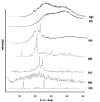Innovative nanostructured lipid-particles of apocynin and clove oil tagged with Chitin oligosaccharide for amelioration of tacrolimus-induced nephrotoxicity
- PMID: 40781522
- PMCID: PMC12334713
- DOI: 10.1038/s41598-025-13978-1
Innovative nanostructured lipid-particles of apocynin and clove oil tagged with Chitin oligosaccharide for amelioration of tacrolimus-induced nephrotoxicity
Abstract
Tacrolimus (FK506) is a potent immunosuppressive agent widely employed to prevent allogeneic rejection in transplant recipients. However, its nephrotoxic effects pose significant limitations to long-term therapeutic use. To address this challenge, the present study aims to develop an innovative oral nano-delivery system designed to mitigate FK506-induced nephrotoxicity through the antioxidant properties of Apocynin (APO), clove oil (CO), and chitin oligosaccharide (CTOS). A nanostructured lipid carrier (NSLC) incorporating APO dissolved in CO and functionalized with CTOS was formulated using ultrasonic emulsification. Gelucire 43/01 and CO served as key lipid components in varying ratios. Physicochemical characterization of the developed NSLCs was conducted, assessing particle size (PS), polydispersity index (PDI), zeta potential (ZP), and encapsulation efficiency (EE%). The optimized formulation (F4) exhibited an EE% of 63.85 ± 1.98, PS of 123 ± 2.21 nm, PDI of 0.17 ± 0.09, and ZP of - 28 ± 1.98, demonstrating a biphasic release profile and stability under refrigerated conditions for six months. In vivo nephroprotective efficacy was evaluated in FK506-induced acute kidney injury (AKI) rat models, where oral administration of APO-loaded NSLCs significantly improved renal function and alleviated nephrotoxicity, as evidenced by biochemical markers and histopathological analyses. These findings underscore the potential of APO-loaded NSLCs as a promising oral phytopharmaceutical strategy for mitigating FK506-associated nephrotoxicity and enhancing therapeutic outcomes in transplant patients. Further studies are warranted to optimize and expand clinical applications.
Keywords: Apocynin; Clove oil; Nanostructured lipid carrier; Nephrotoxicity; Phytopharmaceuticals; Targeted.
© 2025. The Author(s).
Conflict of interest statement
Declarations. Competing interests: The authors declare no competing interests. Ethical approval: The study protocol was reviewed and accepted by the ethical committee of the Faculty of Pharmacy, Mansoura University, Mansoura, Egypt, following the “Principles of Laboratory Animal Care, National Materials Institute of Health Publication (No. 85 − 23, revised 1985)” (Ethical Approval Code 2024 − 163).
Figures







Similar articles
-
Quality by design approach of apocynin loaded clove oil based nanostructured lipid carrier as a prophylactic regimen in hemorrhagic cystitis in vitro and in vivo comprehensive study.Sci Rep. 2024 Aug 19;14(1):19162. doi: 10.1038/s41598-024-68721-z. Sci Rep. 2024. PMID: 39160172 Free PMC article.
-
Development and Characterization of Oral Efavirenz-Loaded Nanostructured Lipid Carriers and Their Optimization with Box-Behnken Design Approach for the Neurological Disorder.Assay Drug Dev Technol. 2025 Feb-Mar;23(2):84-99. doi: 10.1089/adt.2024.115. Epub 2025 Jan 31. Assay Drug Dev Technol. 2025. PMID: 39887046
-
In-situ Nanolipoidal Gel of Stiripentol for Intranasal Administration: Preclinical Evidence of Enhanced Biopharmaceutical and Therapeutic Outcomes.AAPS PharmSciTech. 2025 Aug 25;26(7):220. doi: 10.1208/s12249-025-03209-1. AAPS PharmSciTech. 2025. PMID: 40855034
-
Clinical and cost-effectiveness of newer immunosuppressive regimens in renal transplantation: a systematic review and modelling study.Health Technol Assess. 2005 May;9(21):1-179, iii-iv. doi: 10.3310/hta9210. Health Technol Assess. 2005. PMID: 15899149
-
A Review of Formulation Strategies for Cyclodextrin-Enhanced Solid Lipid Nanoparticles (SLNs) and Nanostructured Lipid Carriers (NLCs).Int J Mol Sci. 2025 Jul 6;26(13):6509. doi: 10.3390/ijms26136509. Int J Mol Sci. 2025. PMID: 40650285 Free PMC article. Review.
References
-
- Yadav, R., Kumar, D., Singh, J. & Jangra, A. Environmental toxicants and nephrotoxicity: implications on mechanisms and therapeutic strategies. Toxicology15378410.1016/j.tox.2024.153784 (2024). - PubMed
-
- Ali, A. S., Almalki, A. S. & Alharthy, B. T. Effect [corrigendum]f Kaempferol [corrigendum]n Tacrolimus-Induced [corrigendum]ephrotoxicity and calcineurin B1 [corrigendum]xpression level [corrigendum]n animal [corrigendum]odel [Corrigendum]. J. Experimental Pharmacology. 1510.2147/JEP.S405132 (2023). :27 – 8.
-
- Abdelrahman, R. S. Protective effect of Apocynin against gentamicin-induced nephrotoxicity in rats. Hum. Exp. Toxicol.37 (1), 27–37. 10.1177/0960327116689716 (2018). - PubMed
-
- Al-Harbi et al. Treatment with Aliskiren ameliorates tacrolimus-induced nephrotoxicity in rats. J. renin-angiotensin-aldosterone Syst.16 (4), 1329–1336. 10.1177/1470320314530178 (2015). - PubMed
-
- Nigam, M. & Phytomedicine Scope and current highlights. In Preparation of phytopharmaceuticals for the management of disorders. Acad. Press. 39–54. 10.1016/B978-0-12-820284-5.00013-7.( (2021).
MeSH terms
Substances
LinkOut - more resources
Full Text Sources

